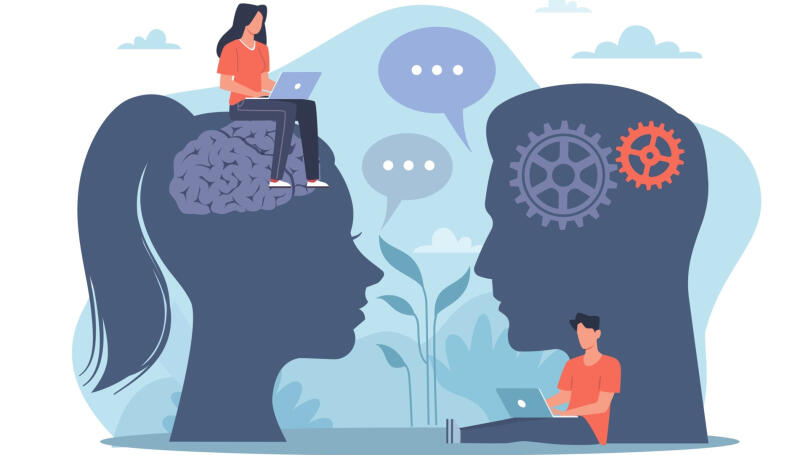Nonverbal communication

What is nonverbal communication?
Nonverbal communication means interaction between people without written or spoken words. In fact, nonverbal communication components also convey certain messages to the interlocutor. However, unlike verbal communication, i.e. verbal interaction, they need to be recognised and understood correctly.
Nonverbal communication involves facial expressions and gestures, tone, pitch, and timbre of voice, intonation, one's gait, postures, almost imperceptible movements, and behaviour during communication in general. All these components are called means of nonverbal communication or body language, by which we inadvertently convey our true feelings and emotions. Nonverbal communication means also supplement verbal speech, enabling us to better understand the interlocutor and determine their level of trust and attitude to the conversation subject.
Thus, the interlocutor's body language not only gives clues on how to interact with them, to give and receive feedback, but also adds supra verbal meaning to their words. All these phenomena are the subject of paralinguistics - it explores a person's voice volume during a conversation, tone of voice, speech rate, pauses and so on. Body language, that is a person's gait and body position, the distance between interlocutors and visual contact are studied by proxemics.
Why is nonverbal communication important?
Researchers exploring nonverbal behaviour agree that body language accounts for more than 50% of communication. Albert Mehrabian, a professor of psychology and specialist in nonverbal communication, established in his research that words a person says convey only 7% of information. At the same time, about 38% accounts for their tone, pitch, timbre, and volume of voice. But most of all - 55% - is communicated by body language, i.e. the person's gestures and facial expressions, gait, posture, and movements.
Research findings bear out the importance and even the need to study nonverbal communication processes. We usually pay attention, first of all, to what the interlocutor says. But it is not the words we use that speak the loudest, but the nonverbal signals. This is because we use elements of nonverbal communication instinctively. So, if the interlocutor can verbally lie, understate or hide information, their subconscious will always reveal the truth. Research has established that nonverbal communication is virtually uncontrollable. People are able to control only their own speech, while body language enables to exchange the information, whose meaning cannot be conveyed by oral speech alone.
Nonverbal communication is also important because information transmitted by verbal interaction gets distorted for a variety of reasons, including:
- the language system drawbacks, for example, its limited nature, potential ambiguity and translation issues;
- the individual's vocabulary and educational background;
- inability to accurately express one's emotions and feelings through words.
Moreover, understanding nonverbal communication allows to tell truth from fiction and to supplement words, amplifying or changing their meaning. It also helps to strengthen relationships between people, to exchange feedback effectively, and to anticipate developments and the nature of future communication. Nonverbal communication also enables to convey information about one's morale and feelings, because if a person cannot talk about their feelings, body language will do it for them.
Nonverbal communication functions

According to the most general classification, nonverbal communication functions:
- support and complement verbal communication as well as transfer information;
- express emotions and current mood;
- establish a connection; for example, eye contact, smiles, and hand shaking help to maintain effective communication with people;
- regulate interaction and control communication process, that is, body language can be a signal to start or end a conversation as well as to change the topic;
- express the attitude towards the interlocutor;
- express individuality; nonverbal elements also reflect unique personality traits and behaviour characteristics.
There is also a shorter list of nonverbal element functions, based on the key purpose of body language - to support verbal communication:
- complementation - where a nonverbal cue confirms a verbal message and complements it;
- duplication - that is, nonverbal elements repeating the message conveyed by words;
- refutation - where nonverbal signals contradict what was said verbally;
- substitution - when body language conveys something different and supersedes words;
- accenting - nonverbal elements emphasize and highlight what has been said with words.
Types of nonverbal communication

There are several systems of nonverbal communication. Among them are:
1. Kinesics
This is the broadest subsystem comprised of facial expressions, body movements and postures, as well as gestures. Each of these elements has its own purpose. For example, mimicry is the movement of facial muscles. It is important to keep in mind that our face can express a huge variety of emotions, even if we do not say a word at that moment. Mimic signals are divided into:
- stable, that is, the face shape and complexion, which also say a lot;
- relatively stable - skin tone and wrinkles;
- unstable - on-and-off movements of facial muscles, twitching, and expression of certain feelings.
Body posture also communicates information to the world around you. People perceive you depending on the way you sit or stand, walk or turn your head. Posture, support and subtle body movements can also vary depending on a variety of factors:
- stage of the communication process;
- attitude towards the other person;
- individual characteristics such as type of temperament;
- psycho-physiological state, etc.
Gesticulation, in turn, involves hand movement. There are several categories of gestures, these include:
- regulators, which control communication speed and pace; they enable to move from one communication stage to another, for example, a palm stretched forward means the desire to interrupt the conversation;
- emblems that replace words or phrases, for example, nodding or pointing a finger in the direction of the conversation subject;
- expressives that convey emotions; a wave of the hands demonstrates surprise, for example;
- adaptors express self-protection and support, for example, frequent hair fixing or nose rubbing;
- illustrators, such as those indicating the size of the object in question.
At the same time, it is important to keep in mind that the same gestures are perceived differently in different cultures and countries. This is due to cultural differences and specifics of peoples. For example, the gesture "everything is OK" is perceived in the USA, Canada, the UK, and Australia positively and implies that things are going well. But it is considered an expression of negative emotions in France. The same applies to the thumbs up gesture - it is a sign of approval or positive reaction in the USA, but the Greeks use it as a request for silence.
Japan has a special gesture culture. It has a huge array of signs and bow varieties, incomprehensible to many Europeans. For example, a nod is used when you greet acquaintances, a bow at a 30 degrees angle is for guests and those higher up on the official ladder, while a deep bow is for the most important people and officials. It is also used to apologize or thank someone.
The gesture system in China is no less complicated. There, a seemingly harmless raised up little finger is the gesture demonstrating contempt and disrespect toward the interlocutor. So, the gesticulation principles - often unobvious - can greatly vary.
2. Proxemics
This subsystem is about the distance or space between interlocutors. The most common classification of distances is the one offered by the American anthropologist and ethnic psychologist Edward Hall, who argues that:
- from 3.5 meters is a public distance suitable for speaking in front of an audience;
- between 1.2 and 3.5 meters is a social distance, comfortable for interacting with officials or strangers;
- between 1.2 meters and 46 cm - a personal or private distance for communication with acquaintances, buddies, and friends;
- between 45 and 15 cm - an intimate distance, suitable for communication only with close ones, parents, and lovers.
So, a person can use physical space to communicate nonverbal messages, for example, a signal of closeness or, on the contrary, aggression, unwillingness to engage in a dialogue, and so on.
Proxemics also includes orientation, that is, the spatial position of interlocutors relative to each other. However, it depends largely on furniture arrangement, chair height, the number of tables and so on.
3. Tacesics
This nonverbal communication subsystem is about tactile (haptic) interaction. People communicate a lot of information just by touching. For example:
- a pat on the shoulder as encouragement or approval;
- a handshake when meeting or saying goodbye as a symbol of openness, affection, and liking;
- stroking as an expression of care, affection, and liking.
4. Olfaction
This system is about the sense of smell, the language of odours and the meanings they convey. For example, the scent of a perfume or a cosmetics item can help one determine the status and financial position of a person, their tastes, and even mood.
5. Paralinguistics
It is about everything that accompanies speech, for example, intonation, speech rate, the voice pitch, volume and timbre, pause duration and word pronunciation rate. All these signals can say a lot about the person and their state at the moment of speech: whether they are calm or excited, confident, sure of what they say and so on. Also, the tone of voice can indicate the interlocutor's mood and their attitude to the conversation topic, for example, express sarcasm, anger, or moderation. The length of pauses and the speech rate can reveal a person's fatigue or, on the contrary, a cheerful mood. In addition, each paralinguistics component can describe a person's unique features and their speech behaviour peculiarities.
6. Extralinguistics
This concept includes various sighs, gasps, groans, and exclamations. Extralinguistics also studies crying and laughter in communication. After all, all these signals speak about the true emotions of a person, help them to express their feelings - anger, fear, offence, disappointment, delight, admiration, and help the interlocutor to better understand them.
How to 'read' nonverbal cues

It is essential to improve your ability to "read" your partner, because all of us occasionally encounter situations that make us doubt our interlocutor's words. So, if you know the unique body language, this will enable you to control the situation, guide the conversation and make communication as effective as possible. First of all, you need to discover the nonverbal signals meaning.
To do this, you need to keep practising and after each dialogue, analyse and evaluate it. It is best to do this in writing. First of all, you need to be as concentrated and attentive as possible during a dialogue, to notice details and almost imperceptible movements, and to keep in mind the matter of the conversation. After that, analyse your communication and answer the following questions in writing:
- Was there an eye contact with the interlocutor? How often and for how long did we look at each other?
- What was the interlocutor's facial expression like? What was their eyebrow position? Was their mouth twisted? Try to identify the emotion on the interlocutor's face during most of the conversation.
- What was the interlocutor's tone? Was it friendly, confident, or tense?
- Was the interlocutor relaxed? Were their shoulders tense? Did they try to stay motionless? Were they calm?
- Was there any physical contact? Was the interlocutor comfortable?
Answers to these questions may show that your negotiation did not go as both parties would have liked at all. However, with regular practice, you will learn, over time, to instantly "read" the interlocutor and achieve your goals.
At the same time, it is very important to apply the same approach to yourself. You will then be able to better control your own nonverbal signals and learn to quickly convince the interlocutor. To do this, pay attention to your emotions and listen to yourself, because you need to understand how your feelings, mood, moral and physical state affect you and your behaviour. This will help to not only find harmony within yourself but also to build trusting relationships with others, to 'read' interlocutors and to understand their hidden motives.
In any case, it is essential to record all communication specifics and analyse even details imperceptible at first glance. After all, to achieve maximum mutual understanding, it is necessary to control the situation and grasp what your interlocutor really thinks and how you should react to it.
Nonverbal communication examples
Smiling is one of the most common nonverbal signals. It expresses liking, friendliness and sometimes affection. For example, a work team greets a new employee with wide and open smiles, expressing encouragement and kindness. At the same time, the manager greets the new employee with a handshake, which can be regarded not only as politeness but also respect.
Next, the employee goes to a meeting with potential investors, arrives at the destination and sees a loud-voiced person with a straight back, calm and confident body movements. He immediately establishes an eye contact, and on saying goodbye not just shakes hands but also pats the visitor on the shoulder. All these signals show that this is an experienced investor or entrepreneur confident in their abilities and interested in working with your company.
When the employee returns to the office, the system administrator greets them - just says a shy hello and quickly walks away - head down and bent back. This indicates that they are insecure, hesitant or even unwilling to communicate with the colleagues.
So, reading nonverbal signals can tell you a lot about your colleagues and acquaintances and help you in your professional and personal life.
How to improve nonverbal communication skills
Specialised literature can help you with this. The most popular books on nonverbal communication are:
- Emotions Revealed: Recognizing Faces and Feelings to Improve Communication and Emotional Life by American psychologist Paul Ekman;
- What Every BODY is Saying by American writer and speaker Joe Navarro;
- The Body Language of Liars: From Little White Lies to Pathological Deception by American interpersonal communication and body language expert Lillian Glass;
- Mind Reading [Examples and Exercises] by the German mentalist Thorsten Havener.
That said, nonverbal communication is such a fast process that it requires you to be completely focused during the communication. After all, if you think about what you haven't had time to say yet, worry about some things that distract you, or check your messenger during the dialogue, you are sure to miss important nonverbal signals that say much more about a person than their words.
In order to fully immerse yourself in communication and better read nonverbal signals, you should learn how to manage stress. After all, it is stress that compromises your ability to have a dialogue. Moreover, when you are stressed, you misinterpret your interlocutor's gestures and other signals; you use misleading nonverbal means. So, stress only aggravates the situation - this often happens during important negotiations or meetings. In such circumstances, take time out and try to find at least a minute to calm down and get back to normal before you rejoin the conversation. Your own feelings can help you restore an emotional balance and cope with stress. Look at what you see around you, what sounds you hear, what smells you sense. Get the feel of all this and your breathing will gradually become normal. Calming movements can also help you cope with stress. For example, look at your favourite pet's picture, breathe in a familiar aroma you are used to, listen to a song from your youth associated with pleasant memories. Depending on your individual psyche, you should find the sensory experience that will help you relax.
The ability to promptly cope with stress directly depends on another factor that also enables to improve nonverbal communication skills. This is emotional awareness, which is all about learning to recognise your own feelings and those of other people, that is, everything that is behind nonverbal cues.
In fact, many people have actually got disconnected from their own emotions, especially those that are commonly thought of as negative. However, when you invalidate or suppress your feelings, you won't be able to get rid of them. And if you improve your emotional awareness, accept and work through all your feelings without dividing them into positive and negative, you'll be able to get rid of their influence on your behaviour and gain control over your own life.
Conclusion
So, nonverbal communication is the most important complement to verbal interaction. After all, it is body language and other signals that enable to create the most complete picture of a person, to find out their motives and goals, to understand their feelings and emotions. Together with verbal communication, it will help to build an efficient strategy of competent interaction and communication.























